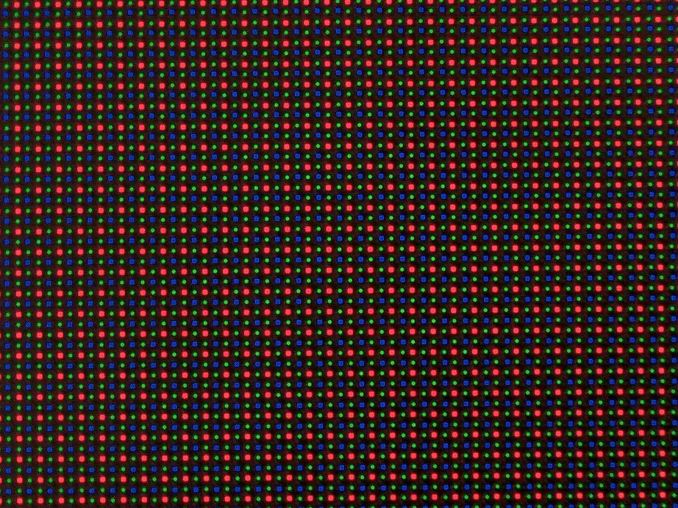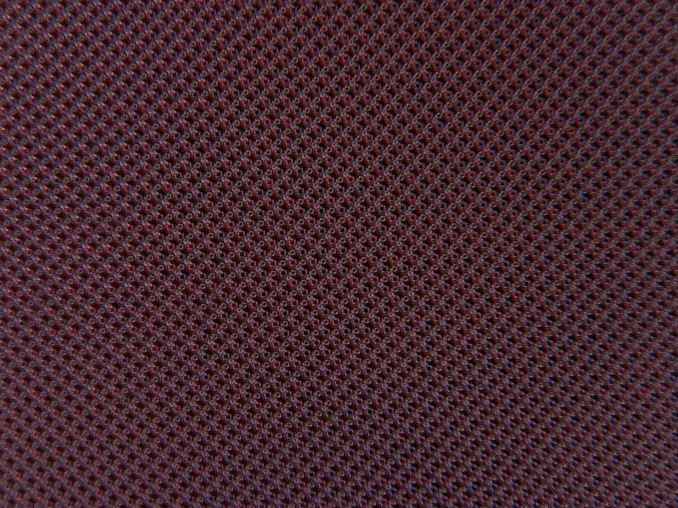A Quick Look at the GS5 LTE-A Subpixel Layout
by Joshua Ho on August 29, 2014 4:47 PM EST
While it was easy to make an educated guess that the Galaxy S5 LTE-A Broadband had a PenTile subpixel layout to support the higher pixel density, I didn't get visual confirmation of this until now. While this picture is rather boring, it's much more interesting to see the display when turned off.
There are a few observations to be made from this photo. While it definitely looks disconcerting and creepy to some, it's possible to make out that there's something set in between the green subpixels when viewed diagonally. This appears to be where the transistors are placed to control a given subpixel. It also seems that the deposition process isn't perfect, as there's noticeable variance in shape and size among subpixels of a given color. This probably explains why the display isn't quite uniform when viewing it at near-black levels. It also appears that there may be an upper bound to how tightly Samsung can place two distinct emitter materials together, as this arrangement has noticeable levels of dead space in between subpixels. In order to better see the full picture, I've included a short gif of the display turning on and off.












21 Comments
View All Comments
Death666Angel - Friday, August 29, 2014 - link
I don't see the unevenness. But that is one weird picture! :DJoshHo - Friday, August 29, 2014 - link
It definitely takes close examination but you can see how the shapes are a bit jagged and they can have some size variation as well.tuxRoller - Friday, August 29, 2014 - link
For comparison's sake, what's the typical variance of an lcd subpixel?JoshHo - Friday, August 29, 2014 - link
The line edge roughness issue is something I haven't seen in LCD.soccerballtux - Saturday, August 30, 2014 - link
I have a better idea for what to do with my saturday!Solandri - Friday, August 29, 2014 - link
For those of you who deride Pentile and worship RGB, here's why Pentile is better. Look at the top picture. Which direction is the top of the phone? Is it left/right? Or up/down?You can't tell because Pentile is symmetric along both axes. One row is RG, the next row is GB. Just as one column is RG, and the next column is BG. That means you can do subpixel rendering along both axes, and you can do it with the same algorithm. Flip your phone/tablet into landscape or portrait mode. Doesn't matter - the subpixel rendering works both ways.
RGB subpixel arrangements can only do subpixel rendering along one axis (usually horizontal). That means a 1920x1080 display using RGB is effectively 5760x1080 with subpixel rendering, with a 1:3 subpixel aspect ratio. You get three times the effective resolution along one axis as you do the other.
Our eyes don't work like that. They have the same resolution in the vertical as in the horizontal. Which is why Pentile can better match the eye's resolving power using fewer subpixels. And why eventually Pentile will beat out RGB.
Crash course on subpixel rendering:
https://www.grc.com/ctwhat.htm
sheh - Friday, August 29, 2014 - link
The main job a display has to do is display whole pixels. Subpixel AA is just a bonus. I find non-RGB displays look worse given similar DPI.marcustyphoon - Friday, August 29, 2014 - link
I believe pretty much every RGB device has left to right subpixels when in portrait, so that would actually be 1920x3240. In any case, I do see your point about subpixel rendering in both directions; the issue is that the pixel model we use really doesn't support Pentile, so practically the antialiasing looks pretty bad. But with Samsung so influential, I wouldn't be surprised if that changed.name99 - Sunday, August 31, 2014 - link
The point is --- does it matter for modern devices?iOS did not use subpixel rendering at first, and and as far as I know STILL does not. (For the reason described --- you can only make it work as expected in two of the four orientations.)
If the company that, arguably, cares the most about the appearance of its screen thinks sub-pixel rendering no longer matters once you hit modern screen densities, maybe it's time to treat it as an interesting (but obsolete) piece of technology trivia from the past --- just like we no longer spend time worrying about the optimal way to dither a 24-bit image to an 8-bit screen.
tuxRoller - Friday, August 29, 2014 - link
At high enough dpi you can simply drop subpixel aa. Some phones are at that point (that newish lg phone with 530dpi).